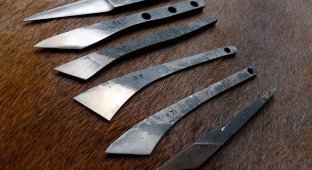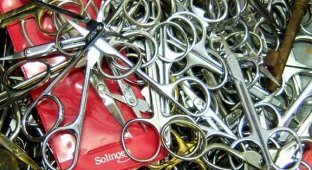How to sharpen kitchen knives to razor sharpness yourself (6 photos + 1 video)
It is difficult to imagine professional cooking without good and sharp knives. A set of knives is the main shrine of any chef and this fact is dictated by practice. However, even if you collect a small collection of knives for different occasions, you will not solve the problem of their sharpness. The fineness of food processing depends on it, and it is better to maintain it yourself.

If you still have a knife in your kitchen, immediately throw it in the trash because it is completely useless and learn to sharpen the knife yourself - you can make sure that there is nothing complicated about it.
Grindstone
Today you may have problems buying a good whetstone - they were once sold in any store, but are now quite rare. However, if you do find such a stone, take care of it, because this thing can be passed on by inheritance. Sharpening stones can be of varying degrees of coarseness. The hardest stones are designed for the most aggressive sharpening; for household use, a medium-grain ceramic block will be sufficient. Metal grinders are often used to sharpen large kitchen knives, but we recommend mastering knife sharpening primarily on stones.

Factory sharpening
All knives are already factory sharpened and in most cases the user is only required to maintain the sharpness of the cutting edge. In order to do this correctly, you need to understand the angle of the cutting edge of the knife. You need to sharpen the knife while trying to maintain this angle. Sharpening at a different angle will take much longer and may damage the blade more quickly.

Correct angle
The sharpening range of the knife should be within an angle of 10 to 30 degrees. The greater the angle, the faster the knife will need sharpening again. One of the most difficult aspects of sharpening knives is maintaining the selected angle. The correct mechanics of movements when sharpening will help you achieve progress.

Hand movements
To make your sharpening more effective, you should make an arcing motion when touching the blade and the stone. Synchronizing this movement and maintaining the angle is the key to success in sharpening a knife. Beginners are advised to place a coin under the back of the blade to maintain the required angle.

Water and oil
A drop of oil added to the sharpening stone will help achieve more effective sharpening. Special mineral oil is best suited for this, but olive oil will do just fine - its job is to lubricate the blade for better glide. However, many people sharpen knives using only water, wetting the stone from time to time.

Strive for imperfection
Many of those who try to sharpen a knife themselves try to bring the blade to a perfect razor sharpness. Such a blade will easily cut paper, but in the case of food, it will quickly become dull and require editing. A rougher and chipped edge of the knife contributes to an additional effect on the fibers of the product, that is, such a knife also acquires the properties of a saw. A coarse sharpening is best suited for meat, vegetables and most other products; in the case of fish, a fine razor sharpening will benefit.























